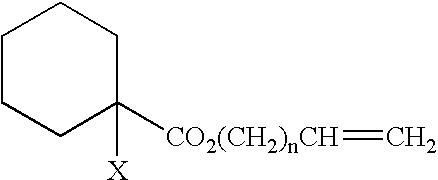Method of treating polymer
a technology of terminal halogen group and vinyl polymer, which is applied in the field of treating the terminal halogen group of vinyl polymer, can solve the problems of difficult industrial production of vinyl polymers, toxicity and/or stability problems, and the halogen content of vinyl polymers is reduced, so as to reduce the halogen content of the polymer
- Summary
- Abstract
- Description
- Claims
- Application Information
AI Technical Summary
Benefits of technology
Problems solved by technology
Method used
Image
Examples
production example 1
Example of Production of a Vinyl Polymer having Both an Alkenyl Group and a Halogen Group
[0139]A 2-liter separable flask equipped with a reflux condenser a and a stirrer was charged with CuBr (8.4 g, 58.5 mmol) and the reaction vessel inside was purged with nitrogen. Acetonitrile (112 mL) was added, and the mixture was stirred at 70° C. on an oil bath for 30 minutes. Thereto were added butyl acrylate (200 g), diethyl 2,5-dibromoadipate (35.1 g, 97.5 mmol) and pentamethyldiethylenetriamine (hereinafter referred to as “triamine”) (1.0 mL, 0.84 g, 4.9 mmol), and the reaction was thus started. While heating at 70° C. with stirring, butyl acrylate (800 g) was added dropwise continuously over 2.5 hours. During dropping of butyl acrylate, triamine (1.0 mL) was supplemented. After the lapse of 4.5 hours after starting the reaction, 1,7-octadiene (144 mL, 107 g, 975 mmol) was added and, then, heating at 70° C. was continued with stirring for 19 hours.
[0140]The reaction mixture was diluted wi...
example 1
Example of Br Treatment
[0142]A 2-liter round-bottom flask equipped with a reflux condenser was charged with the polymer [1] (500 g), potassium benzoate (24 g) and N,N-dimethylacetamide (500 mL), and the mixture was heated at 70° C. with stirring under a nitrogen stream for 11 hours. The N,N -dimethylacetamide was distilled off under reduced pressure, and the residue was then diluted with toluene. The toluene-insoluble solid matter KBr and excess potassium benzoate) was filtered off through an activated alumina column. The volatile matter was distilled off from the filtrate under reduced pressure to give a polymer (polymer [2]).
[0143]Elemental analysis revealed the bromine content in polymer 10 (21 to be 0.1%.
example 2
Example of Polymer Purification
[0144]A 2-liter round-bottom flask equipped with a reflux condenser was charged with the polymer [2] (500 g), aluminum silicate (50 g, product of Kyowa Chemical, Kyowaad 700 PEL) and toluene (1.5 L), and the mixture was heated at 100° C. with stirring under a nitrogen stream for 3 hours. The aluminum silicate was filtered off and the toluene was distilled off from the filtrate under reduced pressure to give a polymer [3].
PUM
| Property | Measurement | Unit |
|---|---|---|
| molecular weight distribution | aaaaa | aaaaa |
| temperature | aaaaa | aaaaa |
| temperature | aaaaa | aaaaa |
Abstract
Description
Claims
Application Information
 Login to View More
Login to View More - R&D
- Intellectual Property
- Life Sciences
- Materials
- Tech Scout
- Unparalleled Data Quality
- Higher Quality Content
- 60% Fewer Hallucinations
Browse by: Latest US Patents, China's latest patents, Technical Efficacy Thesaurus, Application Domain, Technology Topic, Popular Technical Reports.
© 2025 PatSnap. All rights reserved.Legal|Privacy policy|Modern Slavery Act Transparency Statement|Sitemap|About US| Contact US: help@patsnap.com



